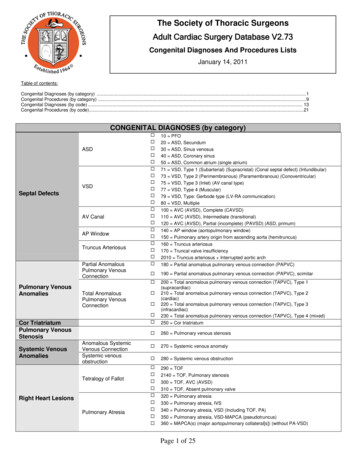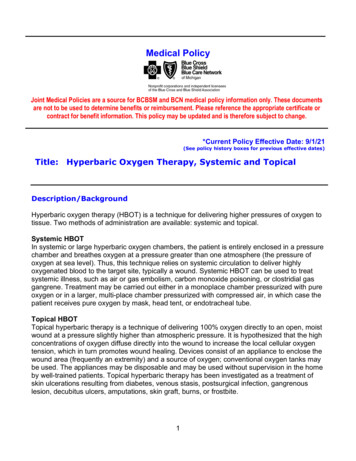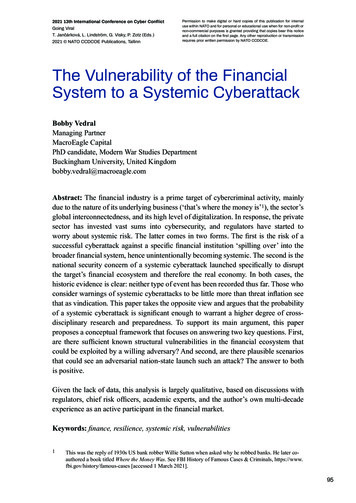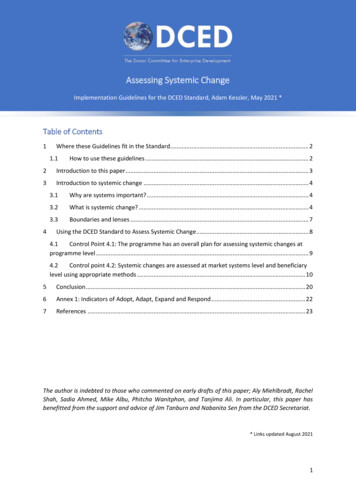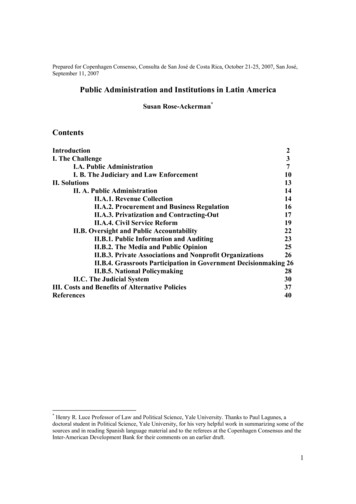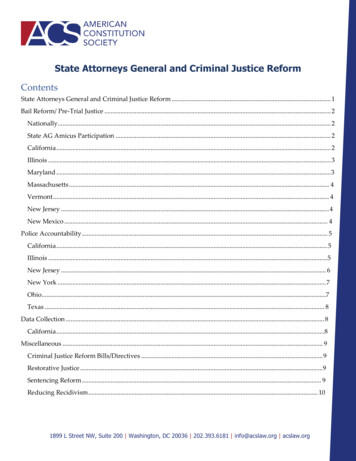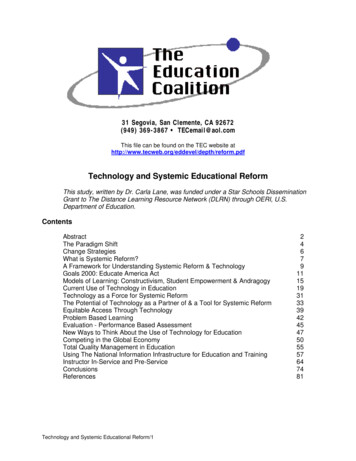
Transcription
31 Segovia, San Clemente, CA 92672(949) 369-3867 TECemail@aol.comThis file can be found on the TEC website chnology and Systemic Educational ReformThis study, written by Dr. Carla Lane, was funded under a Star Schools DisseminationGrant to The Distance Learning Resource Network (DLRN) through OERI, U.S.Department of Education.ContentsAbstractThe Paradigm ShiftChange StrategiesWhat is Systemic Reform?A Framework for Understanding Systemic Reform & TechnologyGoals 2000: Educate America ActModels of Learning: Constructivism, Student Empowerment & AndragogyCurrent Use of Technology in EducationTechnology as a Force for Systemic ReformThe Potential of Technology as a Partner of & a Tool for Systemic ReformEquitable Access Through TechnologyProblem Based LearningEvaluation - Performance Based AssessmentNew Ways to Think About the Use of Technology for EducationCompeting in the Global EconomyTotal Quality Management in EducationUsing The National Information Infrastructure for Education and TrainingInstructor In-Service and Pre-ServiceConclusionsReferencesTechnology and Systemic Educational Reform/124679111519313339424547505557647481
AbstractSystemic reform of education and training is built upon a number of converging events. Thisstudy reviewed the literature in the areas that directly affect systemic reform, and concludes withrecommendations that will enable technology to play a significant role in this movement.Literature from the following areas were reviewed: paradigms, change strategies, systemicreform, Goals 2000, legislation, constructivism, student empowerment, andragogy, equitableaccess, current use of technology in education, problem-based learning, evaluation throughperformance based assessment, technology as a force for systemic reform, technology'spotential as a partner and tool for systemic reform, new ways to think about the use oftechnology for education, competing in the global economy, total quality management ineducation, using the national information infrastructure for education and training, and instructorin-service and pre-service.When "A Nation at Risk" was released in 1983, it sounded an alarm for educators and thenation. It stated that the educational system of the United States was not serving the nation well.Approximately ten years after the release of "A Nation At Risk," the Goals 2000: EducateAmerica Act was signed (March 31, 1994).The Information Infrastructure Task Force (1994) found that the way Americans teach, learn,transmit and access information remains largely unchanged from a century ago. They found thefollowing conditions in American education and training: The textbook remains the basic unit of instruction. Absorption of its contents tends to bethe measure of educational success.Teachers and instructors use "chalk and talk" to convey information. Students are oftenrecipients of instruction rather than active participants in learning.School teachers work largely in isolation from their peers. Teachers interact with theircolleagues only for a few moments each day. Most other professionals collaborate,exchange information and develop new skills on a daily basis.Although half of the nation's school teachers use passive video materials for instruction,only a small fraction have access to interactive video, computer networks, or eventelephones in the classroom.While computers are a frequent sight in America's classrooms and training sites, theyare usually used simply as electronic workbooks. Interactive, high performance uses oftechnology, such as networked teams collaborating to solve real-world problems,retrieving information from electronic libraries, and performing scientific experiments insimulated environments, are all too uncommon."U.S. schooling is a conservative institution, which adopts new practice and technologyslowly. Highly regulated and financed from a limited revenue base, schools serve manyeducational and social purposes, subject to local consent. The use of computertechnology, with its demands on teacher professional development, physical space, timein the instructional day, and budget . has found a place in classroom practice andschool organization slowly and tentatively" (Melmed, 1993)In late June, 1994, the Carnegie Foundation for the Advancement of Teaching reported on theresults of an international survey of 20,000 college professors in five European, four WesternHemisphere and four Asia-Pacific nations, plus Hong Kong. American college professors ratedtheir students the lowest of the 14 countries participating. Only 15 percent said American highschools adequately prepared students for college-level math and quantitative reasoning. Askedif undergraduates are adequately prepared in writing and speaking skills, 20 percent or less ofthe faculty thought so in the United States (San Jose Mercury News 1994).Technology and Systemic Educational Reform/2
Since "A Nation at Risk," a number of forces came into play. As with any paradigm shift, it takesyears and a number of events to reach a critical mass that moves theory and practice forward.Blanchard (1994) refers to "The Structure of Scientific Revolutions," Thomas S. Kuhn's (1970)book which describes how in the history of science, no major discovery ever came from thosescientists who were vested (i.e., job, status, professional reputation) in the current predominantparadigm of thought. Instead, what happened time after time was that a young person (a Turk,maverick or rebel to the scientific community) would discover some finding that could not beexplained by known scientific laws. He (or she) was scoffed at by mainstream scientists whoclung tightly together in blasting the work of the upstart, and if need be the person him/herself.But the young Turk, if persistent, has an ally on his side: truth. And over time other newcomersto the field recognize that truth and a following emerges for a new paradigm that is better able toexplain the current reality as it is now known to all. "Certainly, this describes how early adopters and users of technology in education and traininghave felt. Blanchard (1994) says, "The old "command and control" paradigm is failing becausethose who have been clinging to it (corporate America: GM, IBM, Sears, etc.) are now stumblingand upstart companies that are representing a new era of assumptions about work and thenature of employment are thriving. The fact that Wal-Mart gave ownership interests to all itsemployees has a direct correlation with its rise in overtaking Sears and others on a nationalscale." This all underscores the "fact that the times they are a changin'," says Blanchard.To unlock an epochal technology's power, Magnet (1994) says, companies have learned thatthey must restructure themselves and how they work as they weave computers into their mostbasic processes. "A technological revolution," he says, "is more than a merely technologicalmatter; It entails an organizational transformation too. That's what U.S. business' recent frenzyof re-engineering has been all about, as companies flatten and decentralize along a unifyingnervous system of the new information technology." As education and training has stretched torealign itself with the economy, it too has gone through a frenzy. Downsizing has occurred inteachers, resources, and facilities; technology has not been added, or has been addedsparingly. Criticism has resulted in changes in curriculum, most notably state frameworks andnational standards. Instructional methods have been questioned and new ones put into place.Certainly, this is the basis of systemic reform where schools have decentralized, reorganized,and rethought their production capabilities in the learning and teaching process, and are noworganizing along a unifying nervous system of the new information technology. Educatorsshould become more comfortable with information technology as they become familiar withtechnology, as information has always been their business.There are a number of elements that created the movement for systemic reform and enabledthe passage of the Goals 2000: Educate America Act. The Goals 2000: Educate America Actcovers all Americans; it includes the cradle to grave lifelong learning that has becomenecessary in a global economy. It should not be perceived to cover only K-12 education.Technology and Systemic Educational Reform/3
The Paradigm ShiftBaker (1992) provides the following definitions for paradigm shift:Thomas S. Kuhn (1970): Scientific paradigms are "accepted examples of actual scientificpractice, examples which include law, theory, application, and instrumentation together-- (that)provide models from which spring particular coherent traditions of scientific research."Adam Smith (1975): A shared set of assumptions. The paradigm is the way we perceive theworld; water to the fish. The paradigm explains the world to us and helps us to predict itsbehavior." Smith concludes that "when we are in the middle of the paradigm, it is hard toimagine any other paradigm."Willis Harmon (1970): "The basic way of perceiving, thinking, valuing, and doing associatedwith a particular vision of reality. A dominant paradigm is seldom if ever stated explicitly; it existsas unquestioned, tacit understanding that is transmitted through culture and to succeedinggenerations through direct experience rather than being taught."Barker (1992): "A paradigm is a set of rules and regulations (written or unwritten) that does twothings: (1) it establishes or defines boundaries; and (2) it tells you how to behave inside theboundaries in order to be successful."Barker (1992) identifies the following Paradigm Principles: Our perceptions of the world are strongly influenced by paradigms.Because we become so good at using our present paradigms, we resist changing them.It is the outsider who usually creates the new paradigm.Practitioners of the old paradigm who choose to change to the new paradigm early, mustdo so as an act of faith rather than as the result of factual proof, because there will neverbe enough proof to be convincing in the early stages.Those who change to a successful new paradigm gain a new way of seeing the worldand new approaches for solving problems as a result of the shift to the new rules.A new paradigm puts everyone back to zero, so practitioners of the old paradigm, whomay have had great advantage, lose much or all of their leverage.Barker states that in times of crisis, people expect and demand great change. This willingnessto accept great change generates two results: More people try to find new ways, i.e., newparadigms, to resolve the crisis, thus increasing the likelihood of paradigm shifts. Because ofthe crises mentality, more people willing to accept fundamentally new approaches to solve thecrisis, thus increasing the opportunity to change paradigms. This sets the stage for radicalchange. Barker provides the following sequence for a paradigm shift: The established paradigm begins to be less effective.The affected community senses the situation, begins to lose trust in the old rules.Turbulence grows as trust is reduced (the sense of crisis in creases).Creators or identifiers of the new paradigm step forward to offer their solutions (many ofthese solutions may have been around for decades waiting for this chance).Turbulence increases even more as paradigm conflict becomes apparent.The affected community is extremely upset and demands clear solutions.One of the suggested new paradigms demonstrates ability to solve a small set ofsignificant problems that the old paradigm could not.Some of the affected community accepts the new paradigm as an act of faith.With stronger support and funding, the new paradigm gains momentum.Technology and Systemic Educational Reform/4
Turbulence begins to wane as the new paradigm starts solving the problems and theaffectedcommunity has a new way to deal with the world that seems successful.Technology and Systemic Educational Reform/5
Change StrategiesEven if we know exactly where we want to be in ten years and what the National InformationInfrastructure will be.and even if we knew how much funding we could count on to get us there,we would still need to plan. There is a great body of literature on planning for technology,change, adoption of innovation, and strategies of adoption. As you read through this literaturereview on systemic reform and the use of technology, it may be useful to refer to model changestrategies. Blanchard (1994) suggests that we can "make the times changes faster" throughplanning. His recommendation for a "viable blueprint for the pending evolution (revolution?) isbased on a study of six organizations (Beer, Eisenstat and Spector, 1990) on "the process ofchange that leads to performance improvement." The six-step change strategy includes: Mobilize commitmentDevelop a shared visionFoster consensusSpread revitalization without directiveInstitutionalize revitalization through formal policiesMonitor and adjust strategiesMojkowski (1990) suggests that a strategic approach to technology implementation shouldinclude the following: Consider curriculum and learning outcomes first, then technologyLink the use of technology to organizational prioritiesDevelop a strategic sense guided by the organization's vision, mission, and goalsSimultaneously transform and integrate technology in the learning and teaching processDocument and evaluate the implementationFarrell and Gring (1993) suggest another five-step model that is tied to a milestone timeline. Needs assessment; gathering and analyzing data (where are we today)Shared vision that leads to creating goals (where do we wish to arrive)Select goals - clarify, attainability, measurability and appropriatenessPrioritize goals and write a plan (how do we get from here to there and when)Implement and evaluate the progress of the plan (how do we know when we arrived)Pearson (1989) identified a model specifically for distance education programs. There were nineelements in the program and to be successful, all must be followed. Decide to plan for change: AwarenessRecognize real vs. perceived need: InterestUnderstand the real reason for implementation: AdvantageMission of the organization: EvaluationPlan the program: TrialReview What the organization does now: ObservabilityThe gap: CompatibilityContingency: Pre-Adoption (Pilot)Implementation: AdoptionTechnology and Systemic Educational Reform/6
What is Systemic Reform?During the last decade, it has become obvious that the contributions of teachers, administratorsand the use of technology have made important changes in the lives of students. What becameapparent is that the successes in the classroom needed to be viewed in the larger context of theeducational system and curricula reform. The changes in the larger system were needed inorder to enable wider spread changes in the classroom. Thus we began to use the wordschange, reform, restructure and finally systemic reform which includes K-12, higher educationand training.The National Commission on Time and Learning (1994) states that "Higher education needs toget involved. Colleges and universities, as institutions, have been bystanders for the most partin the school reform debate." They can do this by admissions requirements that validatelearning and not seat time, by aligning programs that educate teachers with the movement tohigher standards (which will require changing offerings in schools of education and the design ofundergraduate programs in core disciplines), and by becoming involved in the struggle toreinvent local schools."We really need to be more involved in collaboration with the public schools," says Dr. ThomasSchnell, associate dean of research at the University of Missouri - St. Louis (1994). "In the pastwe've had our differences. Public school teachers and administrators have viewed colleges asbeing ivory towers with no sympathy for life in the trenches, and colleges have viewed publicschools (teachers) as being practitioners with no appreciation for innovative theory."The goal is still to have an impact on the students, but impacting their learning depends on theteacher and the support that the teacher is receiving from the school's administration, district,higher education, state and federal government. As this definition broadened, other groups wereidentified to be included in system reform. Parents needed to be involved as first teachers andremain involved through their children's academic careers. Schools of education needed to beinvolved as they significantly impacted the pre-service and in-service of teachers andadministrators. Curriculum groups began developing curriculum frameworks for all areas.Performance based assessment and authentic assessment became major movements.Teachers began to learn facilitation methods.Textbook authors, media program producers, the Public Broadcasting System, educationalassociations, teachers' unions, communities, PTAs, county offices of education, statedepartments of education, U.S. Department of Education and the administrations of PresidentsBush and Clinton became involved. Each group defined the contributions it could make as wellas the changes that needed to be made within its structure in order to contribute to successfulsystemic reform. At the federal level, the use of technology was enabled through the StarSchools legislation. The movement became synergistic until finally, interest, understanding, andchange developed a critical mass that enabled the passage of the most sweeping educationallegislation in the history of America, Goals 2000: Educate America Act.Yet another layer of systemic reform deals with time - the time to learn, think, and reorganize forteachers and students. "Unyielding and relentless, the time available in a uniform six-hour dayand a 180-day year is the unacknowledged design flaw in American education," according tothe National Education Committee on Time and Learning (1994). "By relying on time as themetric for school organization and curriculum, we have built a learning enterprise on afoundation of sand, on five premises educators know to be false." The first is the assumptionthat students arrive at school ready to learn in the same way, on the same schedule, all inrhythm with each other. The second is the notion that academic time can be used fornonacademic purposes with no effect on learning. Next is the pretense that because yesterday'sTechnology and Systemic Educational Reform/7
calendar was good enough for us, it should be good enough for our children -- despite majorchanges in the larger society. Fourth is the myth that schools can be transformed without givingteachers the time they need to retool themselves and reorganize their work. Finally, we find anew fiction: it is reasonable to expect 'world-class academic performance' from our studentswithin the time-bound system that is already failing them. These five assumptions are a recipefor a kind of slow-motion social suicide. The key to liberating learning lies in unlocking time."Meyer, Brooks, and Goes (1990) describe discontinuous or second order change as the type ofstrategies organizations employ when confronted by rapid change. "Discontinuous or secondorder change transforms fundamental properties or states of the system." Fullan (1991)describes it as changes which "alter the fundamental ways in which organizations are puttogether, including new goals, structures, and roles."Meyer, Brooks, and Goes (1990) describe two strategies which are used at individual work sitesand at the industry level to react to sudden, jolting changes in the environment. The first ismetamorphosis which is frame-breaking change within an individual organization; the second isrevolution which is described as the emergence, transformation, and decline of entire industries.Conley (1993) distinguishes between three types of changes that schools undergo, sometimessimultaneously. They are renewal, reform, and restructuring. He defines them as follows:"Renewal activities are those that help the organization to do better and/or more efficiently thatwhich it is already doing." "Reform-driven activities are those that alter existing procedures,rules, and requirements to enable the organization to adapt the way it functions to newcircumstances or requirements." "Restructuring activities change fundamental assumptions,practices, and relationships, both within the organization and between the organization and theoutside world."David (1991) says that the central feature of restructuring is that it is a system wide process.For the purposes of this article, systemic reform will be defined as second order change, orrestructuring of educational agencies and processes, at the local, regional and national levels.The dominant thinking about reform and its student level elements is to increase learning,especially advanced or higher-level skills, and to enhance student motivation and self-concept.Reform stresses the elements in the second column of Table 1 (Means, et al, 1993).Table 1.Comparison of Conventional & ReformApproaches to InstructionConventional InstructionReform InstructionTeacher-directedStudent ExplorationDidactic teachingInteractive modes of instructionShort blocks of instruction onExtended blocks of authenticandsingle subjectmulti-disciplinary workIndividual workCollaborative workTeacher as knowledge dispenserTeacher as facilitatorAbility groupingsHeterogeneous groupingsAssessment of fact knowledgePerformance-based assessmentand discrete skillsTechnology and Systemic Educational Reform/8
A Framework for Understanding Systemic Reform and TechnologyElements that have lead to and still are contributing to educational systemic reform andtechnology include a number of significant factors.Global economy Chance that US may become a third world country due to a failure of educationQuality movement - Total Quality Management (TQM)IndustryEducationHealth industryRe-engineering the corporationThe enabling role of information technologyLegislation Clinton Administration concentration on technologyGoals 2000: Educate America ActSchool-to-Work Act1934 and 1994 Communications ActStar Schools Legislation and ProgramsEquitable access for all studentsNTIA ProgramsResearch "A Nation At Risk"Star Schools programsAuthentic Performance AssessmentStudent PortfoliosTeacher PortfoliosTechnological advances National Information InfrastructureDigital fusion/convergence - movement of technologies to tele-computingAbility to provide interactionEasy to use machine interface - user friendlinessInteroperability thorugh worldwide technology standardsCable company advances in the use of interactive programmingGame technologiesTelephone companies wanting to provide programmingCost reductions in technologyComputer Laboratories phased outComputers installed in classrooms with access to information through modemComputer drill and practice phased out in favor of problem solvingMovement from Industrial Age to Information Age to Communications AgeTechnology and Systemic Educational Reform/9
Understanding how to use technology Uses for educationUses for businessUses for homeUses for entertainment - NintendoEducational System Collaborations between K-12 and post-secondaryStar Schools Grant RFP calls for teacher pre-and in-serviceThe system being seen as a system rather than separate entities of parents as firstteachers, pre-school, elementary, middle school, high school, college continuingeducation, training, adult basic education, GED, ESLLearningUnderstanding of learning stylesUnderstanding the mismatch of teaching and learning stylesApplication of learning styles in teachingAttitude change toward technologyFacilitation is used rather than "teaching"Problem solving skills used by all learnersLearners construct their own knowledgeCollaborative study groups are used by all learnersExperiential, hands-on learning used by all learnersSeeing new teaching role models that do more than lecture from the bookMerging of constructivism and andragogyThe Millennium The expectation that something dramatic occurs not only at the change of the centurybut at the end of the second one-thousand years on the planet.As can be seen from the list, any one change or advance was not significant enough to cause aparadigm shift. However, when all of these factors are taken together, the critical mass isestablished that can move the country to a paradigm shift in education.Technology and Systemic Educational Reform/10
Goals 2000: Educate America ActAt the kickoff meeting of Goals 2000: Educate America Act, Secretary of Education RichardRiley said that " technological and economic changes have occurred so fast that even thestandards that we thought were high -- just a few years ago -- have to be higher today if wewant all of our young people to be properly prepared. Technology has been growingexponentially. Education is even more important. We have to strive once again for higherstandards. Here, it is important to recognize that in the next ten years this nation will have morechildren and young people in school than ever before. That's another change. The BabyBoomers filled up our classrooms in the 1960s and '70s, and some of us still remember theenormous amount of effort it took to teach all those children (Riley, 1994b).""Now, we have the same dynamic and something more," Secretary Riley continued. "By year2004, data tells us we will have approximately 55.7 million students going to school, sevenmillion more than we have today. The majority of these young people will not be suburban kids.The majority will be Hispanic, African-Americans, Asian, and new immigrants -- children whocan learn if we teach them to high standards. But we have to expect them to learn and teachthem high standards. If we ignore their education, if we continue to give them a watered-downcurriculum and link inner city schools up last to the Information Superhighway, we will find thiscountry in an economic pickle of the first order. We will have a work force that simply does notknow how to work in today's economy.""Like many of you, Ray Cortines, the very fine chancellor of education in New York city, issetting an example by raising academic standards for every student in New York city. He had itright, a few weeks ago, when he announced the new academic requirement and said that, 'theeasy way out is the road to nowhere.' We can all find an easy way out. For that is the heart ofthe matter. If we accept 'the easy way out,' it will surely be the road to nowhere for a generationof young people who need our help. It will be a great injustice to their families and costly to thisgreat nation of our's. We must do this for all of our students - - our most talented students aswell as all those young people who are in the middle, students from disadvantagedbackgrounds, students whose first language is not English, and students with disabilities. Evenhomeless students like those who are being taught by our National Teacher of the Year, SandraMcBrayer -- San Diego children who have no one to speak up for them -- who go to college likemany of Sandra's students.if we believe in them. We need to remember that good teacherslike Sandra are at the heart of it all. They make the difference. If we want our children to be'living report cards,' we simply have to honor the work and effort of America's teachers -- andlisten to what they are telling us about our children. They simply have to be at the very center ofour reform efforts. If you try to reform the schools in any other way, it will fail" (Riley, 1994b)."Americans want the best for our children. They always have. They know our children need tolearn more to get ahead.that the world they are growing up in is so different than the one thateven all of us grew up in.more global, more knowledge-driven and certainly it's morecompetitive. This is why Goals 2000 is at the very center of an effort to redesign the Americaneducation system for the coming times -- to create a strategy of lifelong learning that beings withit Head Start and Even Start and many other pre-school programs.that makes our schoolssafer.that raises standards and expectations across-the-board at the K-12 level.that helpsyoung people make the transition from school-to-work.that prepares many more young peoplefor college or other postsecondary learning. Goals 2000 is your act - your victory, yourachievement.and our opportunity.together.to lift up American education (Riley, 1994b).In March, 1994, Goals 2000: Educate America Act legislation was passed and signed into law.It's preamble states: "To improve learning and teaching by providing a national framework foreducation reform; to promote the research, consensus building, and systemic changes neededTechnology and Systemic Educational Reform/11
to ensure equitable educational opportunities and high levels of educational achievement for allstudents; to provide a framework for reauthorization of all Federal education programs; topromote the development and adoption of a voluntary national system of skill standards andcertifications; and for other purposes."The Goals School Readiness: By the year 2000, all children in America will start school ready tolearn.School Completion: By the year 2000, the high school graduation rate will increase to atleast 90 percent.Student Achievement and Citizenship: By the year 2000, all students will leave grades 4,8, and 12 having demonstrated competency over challenging subject matter includingEnglish, mathematics, science, foreign languages, civics and government, economics,arts, history, and geography, and every school in America will ensure that all studentslearn to use their minds well, so they may be prepared for responsible citizenship, furtherlearning, and product
A Framework for Understanding Systemic Reform & Technology 9 Goals 2000: Educate America Act 11 Models of Learning: Constructivism, Student Empowerment & Andragogy 15 Current Use of Technology in Education 19 Technology as a Force for Systemic Reform 31 The Potential of Technology as a Partner of & a Tool for Systemic Reform 33
